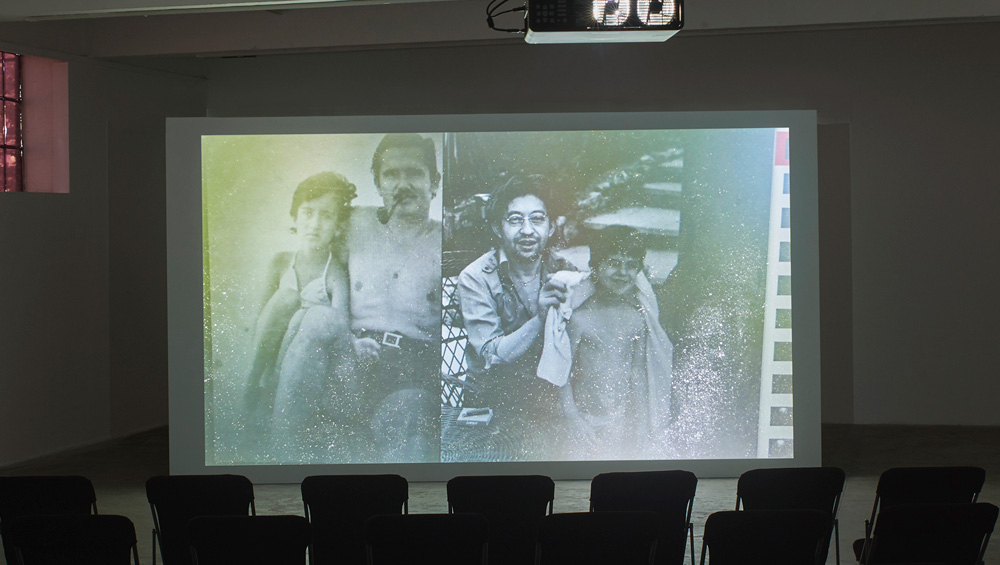
by HATTY NESTOR
The refugee crisis increasingly raises questions of protection, vulnerability and citizenship. From the large camp in Calais, and reports from the camps in Greece and the detention centres at the Mexican border with the United States, societally we are always reminded of those who are not bound to a particular time and place, and whose whereabouts are often unknown. As Charlotte McDonald-Gibson writes in her recent book Cast Away: Stories of Survival from Europe’s Refugee Crisis: “It is all too easy for the government and public to turn away.” Can art bear witness to these complex political questions of citizenship, belonging?
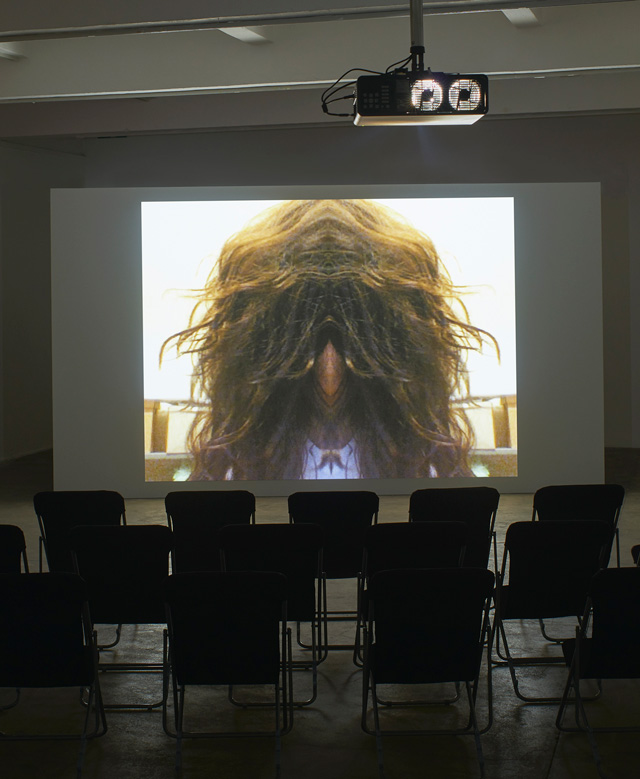
Banu Cennetoğlu. 1 January 1970 – 21 March 2018 · H O W B E I T · Guilty feet have got no rhythm · Keçiboynuzu · AS IS · MurMur · I measure every grief I meet · Taq u Raq · A piercing Comfort it affords · Stitch · Made in Fall · Yes. But. We had a golden heart. · One day soon I’m gonna tell the moon about the crying game (2018). Installation view, Chisenhale Gallery, 2018. Commissioned and produced by Chisenhale Gallery, London. Courtesy of the artist. Photo: Andy Keate.
Banu Cennetoğlu’s recent exhibition at the Chisenhale gallery, comprised of 13 titles, beginning with HOWBEIT, conceptualised these questions through a myriad of thoughtful, politically charged works. The inherent violence of border control politics and policies and how they sanction, isolate and divide were central to this show. Now based in Istanbul, Cennetoğlu, who was born in Ankara in 1970, studied psychology at Boğaziçi University in Istanbul before going on to study photography at Speos International Photography School in Paris and then visual arts at the Rijksakademie in Amsterdam. She has been a guest at the DAAD Artists-in-Berlin program and has exhibited work at Documenta 14 and the Walker Art Centre in Minneapolis, among others. Her work is also on show at the current Liverpool Biennial. She founded BAS, an artist-run space in Istanbul where artists’ books and publications are collected, displayed and produced. She is represented by the Rodeo Gallery in London.
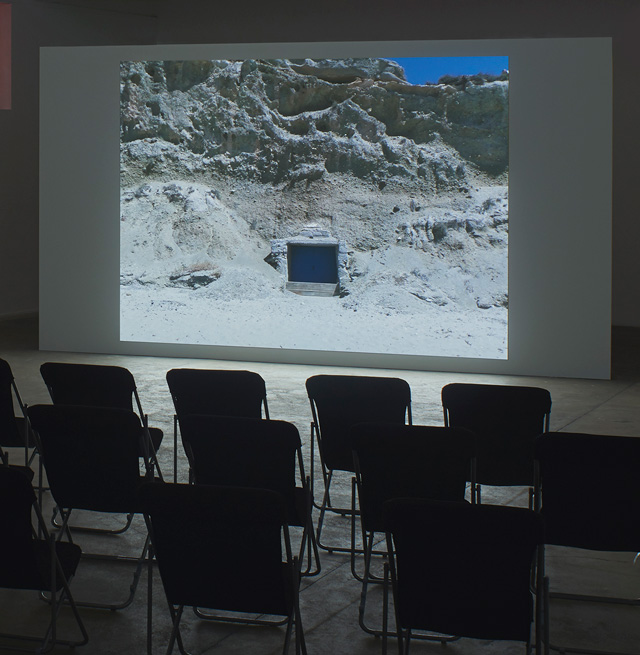
Banu Cennetoğlu. 1 January 1970 – 21 March 2018 · H O W B E I T · Guilty feet have got no rhythm · Keçiboynuzu · AS IS · MurMur · I measure every grief I meet · Taq u Raq · A piercing Comfort it affords · Stitch · Made in Fall · Yes. But. We had a golden heart. · One day soon I’m gonna tell the moon about the crying game (2018). Installation view, Chisenhale Gallery, 2018. Commissioned and produced by Chisenhale Gallery, London. Courtesy of the artist. Photo: Andy Keate.
Arresting in its execution of collective consciousness, trauma and memory, Cennetoğlu’s moving-image installation at the Chisenhale Gallery also allowed the viewer to experience flashes of the artist’s own biography throughout the 128 hour and 22-minute film. Moments with her daughter were particularly tender, yet her poignant meditation on individual and collective consciousness addressed the question of responsibility to others, making for an astutely charted documentation of the human subject. The installation was a meditation on identity and how, ultimately, we cannot categorise our own, or that of others.
In conjunction with the exhibition at the Chisenhale, Cennetoğlu also facilitated the distribution of The List, which details the 34,361 refugees and migrants known to have lost their lives attempting to reach Europe since 1993. This is a project she has worked on for the past 11 years, in collaboration with United for Intercultural Action, a European network of more than 560 anti-racist organisations in 48 countries. There are clear parallels with Cennetoğlu’s other work. For instance, in Documenta 14, in 2017, she showed two works – one based around the diary of a Kurdish fighter in the 1990s and the other fixing the words “Being safe is scary” over the neoclassical portal of Kassel’s Fridericianum museum – both of which were reflections on the migrant crisis and politics of memory. However, this is the first time since its conception that the List has been distributed to a UK audience – it can be viewed on the Chisenhale and the Guardian websites.
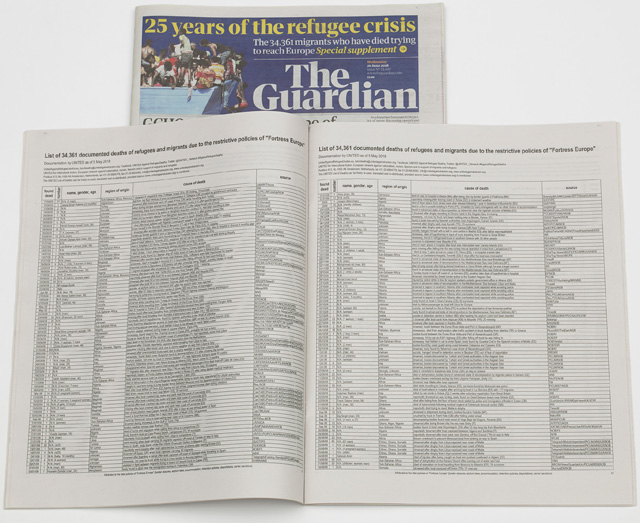
List of 34,361 documented deaths of refugees and migrants due to the restrictive policies of Fortress Europe. Documentation as of May 5, 2018 by UNITED for Intercultural Action. This edition of The List is produced by Chisenhale Gallery and Liverpool Biennial, and printed and distributed by The Guardian on World Refugee Day, 20 June 2018. Copies of the newspaper with the 64-page supplement are available at Chisenhale Gallery (28 June–26 August 2018) and Liverpool Biennial (14 July–28 October 2018).
Talking to Cennetoğlu, her empathetic stance and desire to create a sense of togetherness is poignantly clear. Complex ethical questions about human existence lead to a consideration of how, in the current political climate, we document those deemed unworthy of protection. I was curious to understand Cennetoğlu’s thoughts about speaking for others, and how to present them artistically and ethically. What was most alluring, and indeed brave, about HOWBEIT was its ability to demonstrate this powerlessness in the face of marginalisation. Cennetoğlu believes that, through working together as a collective body, we can find the greatest strength.
Hatty Nestor: Can you talk about how the commission for the Chisenhale Gallery was conceived, and the curational thought behind it?
BC: The invitation came almost two years ago, and the whole time we worked very carefully and with mutual trust, which is crucial for such work. It was a thorough collaboration both for the work in the gallery and the distribution of the List. The duration of the work follows the gallery’s opening hours, six hours a day [each day a new six-hour long file of the 128 hour and 22-minute work is shown]. There are 22 parts, and throughout the whole show, it loops only once. It is a piece that needs maintenance, guidance and endurance.
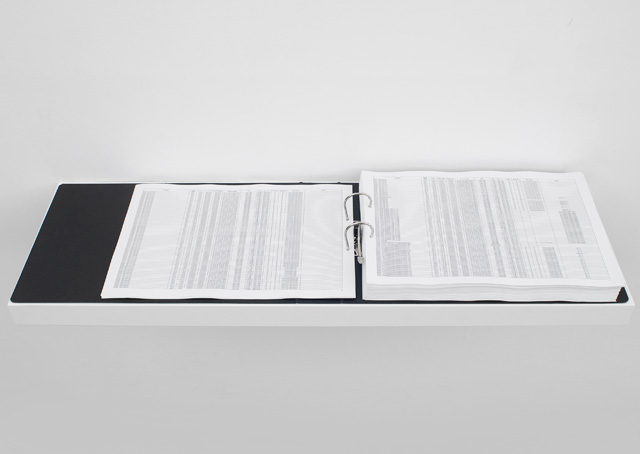
Banu Cennetoğlu. 1 January 1970 – 21 March 2018 · H O W B E I T · Guilty feet have got no rhythm · Keçiboynuzu · AS IS · MurMur · I measure every grief I meet · Taq u Raq · A piercing Comfort it affords · Stitch · Made in Fall · Yes. But. We had a golden heart. · One day soon I’m gonna tell the moon about the crying game (2018). 599 paper pages, 297 x 420 mm. Commissioned and produced by Chisenhale Gallery, London. Courtesy of the artist. Photo: Andy Keate.
HN: The title of the commission is comprised of 13 phrases. I read in an interview with the gallery’s curator of commissions, Ellen Greig, that this was because all the titles felt relevant. From where did they all derive?
BC: Choosing one over the other did not feel “just” for this work, so I kept all those that had stayed with me for eight months. I was also inspired by Clarice Lispector’s novel The Hour of the Star, or its 12 suggested titles, although mine is not “or” but “and”.
HN: Collective and individual memory in HOWBEIT carve out political space to discuss collective consciousness, despite many fragments of the installation meditating on your own biography, such as your daughter’s birth. Did this autobiographical element feel essential when situated in a broader sociopolitical sphere?
BC: The installation is about both. Depending on what you saw in the film, you’ll have your narrative of it, which is essential to the piece. The work is compiled from all the digital images and videos I have from the last 12 years, one year before the conception of my daughter and the first dissemination of the List, in Amsterdam. I did not want to choose and create a hierarchy within the compiled and kept; I wanted to see the border between the personal and public as quite blurred, especially with identity. I was interested in the decomposition of identities, coming from a conflicted and contrasted feeling. I wanted to see the juxtaposition of how we prioritise our responsibilities to others, the images we create of other people and our own lives.
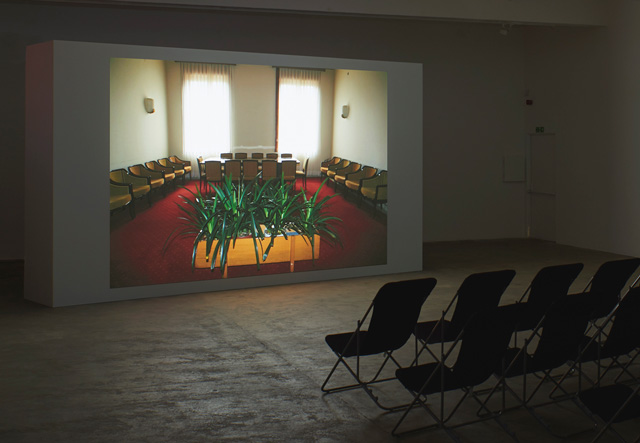
Banu Cennetoğlu. 1 January 1970 – 21 March 2018 · H O W B E I T · Guilty feet have got no rhythm · Keçiboynuzu · AS IS · MurMur · I measure every grief I meet · Taq u Raq · A piercing Comfort it affords · Stitch · Made in Fall · Yes. But. We had a golden heart. · One day soon I’m gonna tell the moon about the crying game (2018). Installation view, Chisenhale Gallery, 2018. Commissioned and produced by Chisenhale Gallery, London. Courtesy of the artist. Photo: Andy Keate.
HN: So your method of creating the work reflects your rejection of creating a hierarchy of material?
BC: Yes, precisely, and it creates a new order. Valuing and creating a hierarchy by importance is not there. Everything is included: the boring, the exciting and the mundane aspects of life. Some of the representations are life-changing, too. But nothing is resolved or finished in this work; it is always a continuous, evolving thing.
HN: Is the fact that the work is ongoing, and not necessarily resolved, similar to the List, which you have been compiling since 2007. The nature of the List inevitably means it can never have an ending.
BC: I don’t think they are comparable in that manner, because the way I compiled the images, at least the majority, when I shot or put them together, I had no initial intention of sharing them. There are also complete artworks in it – the making of them, the trials and errors – as well as downloads and images that people sent me, which I didn’t delete. I don’t erase many things. The footage is somehow repetitive, things come back in a different time or context, with different names. I have an entire collection of slides from the late 1990s, which were scanned in 2007 for another work. I can’t compare it with the List because that has a clear protocol and an apparent reason for existing. The fragmented and incomplete continuity and precariousness in both works are very different.
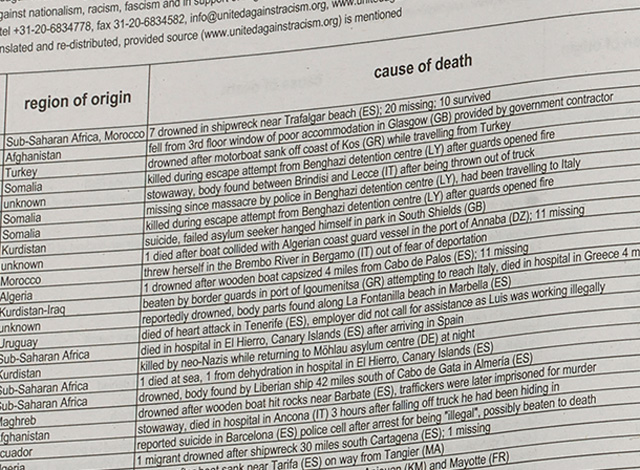
List of 34,361 documented deaths of refugees and migrants due to the restrictive policies of Fortress Europe (detail). Documentation as of May 5, 2018 by UNITED for Intercultural Action. This edition of The List is produced by Chisenhale Gallery and Liverpool Biennial, and printed and distributed by The Guardian on World Refugee Day, 20 June 2018. Copies of the newspaper with the 64-page supplement are available at Chisenhale Gallery (28 June–26 August 2018) and Liverpool Biennial (14 July–28 October 2018).
HN: Many of the themes in your work relate to current sociopolitical and economic conversations of collective consciousness and the power of resistance in numbers. I was looking through the suggested reading list on the Chisenhale website, which you and the gallery’s curatorial team compiled to accompany the exhibition, and Vulnerability in Resistance jumped out. In one of the chapters, Judith Butler talks about vulnerability as collective empowerment. Did this theoretical grounding inform your work?
BC: There is always vulnerability in resistance. This book, which was co-edited by Butler, Zeynep Gambetti and Leticia Sabsay, is excellent regarding thinking about the resilience and vulnerability together and not polarised, and the public space as being an intersection of all these different dynamics and rhythms, which is a vulnerability in itself. It’s not about victimisations, but accepting a co-existence. There is a certain agony that I find very interesting, in the sense that, especially where I come from, there is a very long and challenging history of coexistence. The government tries to manipulate and make this coexistence impossible. The moment you acknowledge the existence of vulnerability, you accept who you are and the conflict which comes with it. We don’t have to “adore” each other (relevant also for different versions of oneself), but we can live alongside one another. Acceptance is significant energy and power, and you can change things with it.
HN: Yes, and that acceptance and difference are reflected in a major theme in your work, borders and mapping. How do you think about borders in a world that seeks to isolate and sanction different nationalities?
BC: The basis of it is fear policy – found in Turkey, Russia, Poland, UK, France, to name few. The fear of the “unknown” and not being interested in knowing facilitates the manipulation by politicians. What’s happening to people between borders is just one manifestation of these policies and their followers.
HN: The idea of ownership and safety can become perpetuated when they are led by fear.
BC: Exactly, it’s easy with HOWBEIT to only see the artist’s life in it. However, in creating it, and giving it public visibility, I hoped it could live outside the first encounter. It is about me, but it also isn’t about me, I am just the vessel. One defining thing for me was the existence of a child. You document life more than you usually do, because of a birthday party or celebration – one feels obligated to do it or wants to do it. It comes with different engagements and identities and politics of living.
HN: So, on the one hand, it defines the intimacy and closeness, alongside people you might not know, but they are all on an equal plane of importance.
BC: Well, that’s good to hear! Going back to the hierarchy of images, I had a work called CATALOG for Turkey’s pavilion at the 2009 Venice Biennale, which was a catalogue of 500 edited pictures, mimicking a mail-order catalogue, where the images were offered free during the biennale. I was living in New York in 2001 and I had seven slides of the World Trade Center collapsing. Afterwards, I had to ask ethically and artistically what I should do with those images. I never wanted to show them as the main subject of an exhibition, but I decided they could be displayed next to something that has nothing to do with these images, as a montage of everyday life.
HN: It seems to be a question of context. In thinking of yourself as a vessel, the meaning of art also gives you access to and resources of a wider audience. The context of these exhibitions provides visibility. Your work seems to function within these institutional concerns?
BC: I am interested in questioning the positions of institutions, partners and collaborators. I’m interested in thinking and conceptualising all the negotiations involved in the process of working with people, and these spaces are critical to me, the creation, dissemination, the process required before the final product. Going back to the film, it is a non-hierarchical mixture of politically charged footage alongside my daughter’s birthday which shows that’s just how we live. I needed to make this work because there is a contradictory element to life and the normalisation of extreme things, but we go on; life goes on. The need to share and make it open was necessary.
• http://www.biennial.com/2018/exhibition/artists/banu-cennetoglu, which Banu Cennetoğlu helped to compile is on show at the Liverpool Biennial until 28 October 2018. Her exhibition of 13 moving images, HOWBEIT · Guilty feet have got no rhythm · Keçiboynuzu · AS IS · MurMur · I measure every grief I meet · Taq u Raq · A piercing Comfort it affords · Stitch · Made in Fall · Yes. But. We had a golden heart. · One day soon I’m gonna tell the moon about the crying game, was at the Chisenhale Gallery, London.